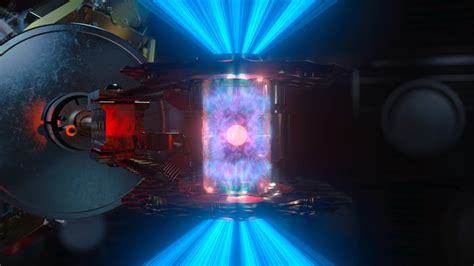
Scientists have achieved a significant energy breakthrough by harnessing technology originally developed for video games to manage and optimize plasma within fusion reactors, paving the way for more efficient and sustainable energy production. Researchers at the UK Atomic Energy Authority (UKAEA) have utilized advanced algorithms initially designed for real-time decision-making in video games to stabilize and control the volatile plasma within a tokamak reactor, a crucial step towards realizing practical fusion energy.
The breakthrough, hailed as “crucial” by scientists, tackles one of the most significant challenges in fusion research: maintaining a stable and sustained plasma environment hot enough to enable nuclear fusion to occur. Fusion, the same process that powers the sun, holds the promise of virtually limitless, clean energy, but replicating these conditions on Earth requires extreme precision and control. The technology addresses this by using sophisticated algorithms to predict and react to plasma instabilities in real-time, preventing disruptions that can halt the fusion reaction and damage the reactor.
“We are using techniques developed for the gaming industry to solve a really hard problem for fusion,” said Dr. Lee Margetts, leader of the UKAEA team responsible for the innovation. “The video game technology allows us to respond to changes in the plasma much faster than traditional methods.”
The core of the innovation lies in the application of reinforcement learning, a type of machine learning where an agent learns to make decisions by trial and error to maximize a reward. In this case, the “agent” is the algorithm, and the “reward” is a stable and sustained plasma. The algorithm is trained on vast amounts of simulated plasma data and then deployed to control the real-world tokamak. This allows the system to learn optimal control strategies that would be impossible to derive through traditional physics-based modeling.
The Challenge of Plasma Control
Plasma, often described as the fourth state of matter, is a superheated gas in which electrons are stripped from atoms, creating a mixture of ions and free electrons. Achieving fusion requires heating plasma to temperatures exceeding 100 million degrees Celsius, far hotter than the sun’s core. At these extreme temperatures, the plasma becomes highly unstable and prone to disruptions.
These disruptions, sudden and violent events, can cause the plasma to lose its confinement and rapidly cool, halting the fusion reaction. Moreover, disruptions can generate intense heat loads and electromagnetic forces that can damage the reactor’s internal components. Preventing disruptions is therefore essential for the safe and efficient operation of fusion reactors.
Traditional methods of plasma control rely on feedback systems that measure various plasma parameters, such as temperature, density, and magnetic field, and then adjust control actuators, such as magnetic coils and particle injectors, to maintain the desired conditions. However, these traditional methods often struggle to react quickly enough to prevent disruptions, which can develop in milliseconds.
The Video Game Connection
The key to the UKAEA’s breakthrough is the use of algorithms originally developed for real-time decision-making in video games. These algorithms are designed to allow computer-controlled characters to react to rapidly changing environments and make optimal decisions in complex situations.
Reinforcement learning, in particular, has proven to be a powerful tool for plasma control. By training an algorithm on vast amounts of simulated plasma data, researchers can create a system that can predict and react to plasma instabilities in real-time. This allows the system to take proactive measures to prevent disruptions before they occur.
The application of video game technology to fusion research is a prime example of how innovation can arise from unexpected places. The gaming industry has invested heavily in developing algorithms for real-time decision-making, and these algorithms are now finding applications in a wide range of fields, including energy, robotics, and healthcare.
The UKAEA’s Approach
The UKAEA team is using a reinforcement learning algorithm to control the plasma in the Mega Amp Spherical Tokamak (MAST) Upgrade, a spherical tokamak reactor located at the Culham Centre for Fusion Energy in Oxfordshire, UK. The MAST Upgrade is designed to study the behavior of plasma in a more compact and efficient configuration than traditional tokamak reactors.
The reinforcement learning algorithm is trained on data from MAST Upgrade simulations. The simulations are based on detailed physics models of the plasma and the reactor’s control systems. By training the algorithm on these simulations, the researchers can create a system that can effectively control the plasma in the real-world reactor.
The algorithm works by continuously monitoring the plasma and predicting the likelihood of a disruption. If a disruption is predicted, the algorithm takes corrective actions, such as adjusting the magnetic fields or injecting particles into the plasma. These actions are designed to stabilize the plasma and prevent the disruption from occurring.
The UKAEA team has demonstrated that their reinforcement learning algorithm can significantly improve the stability and performance of the plasma in the MAST Upgrade. In experiments, the algorithm has been shown to reduce the frequency of disruptions and increase the duration of stable plasma discharges.
Implications for Fusion Energy
The UKAEA’s breakthrough has significant implications for the future of fusion energy. By demonstrating that video game technology can be used to effectively control plasma in fusion reactors, the researchers have taken a major step towards making fusion energy a practical reality.
The ability to prevent disruptions is essential for the safe and efficient operation of fusion reactors. Disruptions can damage the reactor’s internal components and halt the fusion reaction, reducing the reactor’s overall performance and increasing its operating costs. By reducing the frequency of disruptions, the UKAEA’s technology can improve the reliability and economic viability of fusion energy.
Moreover, the UKAEA’s technology can enable the development of more compact and efficient fusion reactors. Spherical tokamaks, such as the MAST Upgrade, are designed to be smaller and more efficient than traditional tokamak reactors. However, spherical tokamaks are also more prone to disruptions. By using reinforcement learning to control the plasma in spherical tokamaks, the UKAEA’s technology can enable the development of more compact and affordable fusion power plants.
The breakthrough also highlights the potential of machine learning for solving complex problems in fusion research. Machine learning algorithms can be trained on vast amounts of data to identify patterns and make predictions that would be impossible for humans to discern. This opens up new possibilities for optimizing the design and operation of fusion reactors.
Future Directions
The UKAEA team is continuing to develop and refine their reinforcement learning algorithm. They are working to improve the algorithm’s accuracy and robustness and to extend its capabilities to control a wider range of plasma parameters.
The researchers are also exploring the use of other machine learning techniques for fusion research. They are investigating the use of machine learning to predict the performance of fusion reactors, to optimize the design of reactor components, and to diagnose problems in the reactor’s operation.
The UKAEA’s work is part of a global effort to develop fusion energy as a clean and sustainable energy source. Fusion research is being conducted in many countries around the world, and international collaborations are playing an increasingly important role in advancing the field.
International Collaboration: A Key to Fusion’s Future
The pursuit of fusion energy is a global endeavor, with significant research and development efforts underway in numerous countries. The UKAEA actively participates in international collaborations, recognizing that shared knowledge and resources are essential to accelerating progress in this complex field. One prominent example of such collaboration is the ITER project.
ITER (International Thermonuclear Experimental Reactor) is a large-scale international fusion experiment being built in southern France. It is a joint project of the European Union, the United States, Russia, China, Japan, South Korea, and India. ITER’s goal is to demonstrate the scientific and technological feasibility of fusion energy.
The UKAEA is contributing to ITER in several ways, including by developing and testing plasma control systems. The knowledge and experience gained from the UKAEA’s research on the MAST Upgrade is being used to develop advanced control algorithms for ITER.
In addition to ITER, the UKAEA is also collaborating with other fusion research organizations around the world. These collaborations involve the exchange of data, expertise, and personnel. By working together, researchers can accelerate the pace of innovation and overcome the challenges of developing fusion energy.
Economic and Environmental Benefits of Fusion Energy
Fusion energy offers the potential for significant economic and environmental benefits. Fusion power plants would use readily available fuels, such as deuterium (a form of hydrogen found in seawater) and tritium (which can be produced from lithium). These fuels are abundant and geographically diverse, reducing the risk of energy dependence and price volatility.
Fusion energy is also a clean energy source. It does not produce greenhouse gases or air pollutants. The only byproduct of the fusion reaction is helium, an inert and non-toxic gas. Fusion power plants would also produce very little radioactive waste, and the waste that is produced would be relatively short-lived compared to the waste from nuclear fission reactors.
The economic benefits of fusion energy would be substantial. Fusion power plants would provide a reliable and affordable source of electricity, which could help to reduce energy costs for consumers and businesses. Fusion energy could also create new jobs in the energy sector and in related industries.
The development of fusion energy would also have significant geopolitical implications. Fusion energy could reduce the world’s dependence on fossil fuels, which could help to stabilize energy markets and reduce the risk of conflict over energy resources.
Public Perception and Acceptance
Public perception and acceptance are crucial for the successful deployment of any new energy technology, including fusion. While fusion energy is generally viewed favorably by the public due to its potential for clean and sustainable energy, there are also some concerns about safety and cost.
Addressing these concerns is essential for building public support for fusion energy. It is important to communicate the benefits of fusion energy clearly and accurately, and to address any misconceptions about the technology. It is also important to involve the public in the decision-making process regarding the development and deployment of fusion energy.
Transparency and open communication are key to building public trust in fusion energy. Researchers and policymakers should be open about the challenges of developing fusion energy and should be willing to address any questions or concerns that the public may have.
Conclusion: A Promising Step Towards Sustainable Energy
The UKAEA’s breakthrough in using video game technology to control plasma in fusion reactors represents a significant step forward in the quest for clean and sustainable energy. By harnessing the power of machine learning, researchers are overcoming some of the most challenging obstacles to making fusion energy a practical reality.
While significant challenges remain, the progress being made in fusion research is encouraging. With continued investment and international collaboration, fusion energy could play a major role in meeting the world’s growing energy demands while protecting the environment. The application of unexpected technologies, like those from the gaming industry, underscores the importance of cross-disciplinary innovation in tackling complex scientific problems. The “crucial” breakthrough demonstrates how innovative solutions can pave the way for a brighter, more sustainable energy future powered by fusion. The next steps involve scaling up these techniques and applying them to larger, more complex fusion reactors, bringing us closer to a future where clean, limitless energy is a reality.
Frequently Asked Questions (FAQ)
-
What is nuclear fusion and why is it important?
Nuclear fusion is the process that powers the sun and other stars. It involves combining light atomic nuclei, such as hydrogen isotopes, to form heavier nuclei, such as helium. This process releases tremendous amounts of energy. Fusion is important because it has the potential to provide a virtually limitless, clean, and sustainable source of energy. The fuels for fusion are abundant and readily available, and the process does not produce greenhouse gases or long-lived radioactive waste.
-
What is a tokamak reactor and how does it work?
A tokamak is a type of fusion reactor that uses powerful magnetic fields to confine and control plasma, a superheated gas in which fusion reactions can occur. The magnetic fields are created by a series of coils surrounding a toroidal (donut-shaped) vacuum chamber. The plasma is heated to extremely high temperatures, typically exceeding 100 million degrees Celsius, to initiate fusion reactions. The energy released by the fusion reactions heats the plasma further, sustaining the reaction.
-
What is the role of plasma control in fusion reactors?
Plasma control is essential for the safe and efficient operation of fusion reactors. Plasma is inherently unstable and prone to disruptions, which are sudden and violent events that can cause the plasma to lose its confinement and rapidly cool. Disruptions can damage the reactor’s internal components and halt the fusion reaction. Plasma control systems use a variety of techniques to monitor and stabilize the plasma, preventing disruptions and maintaining the conditions necessary for sustained fusion reactions.
-
How is video game technology being used in fusion research?
Researchers are using algorithms originally developed for real-time decision-making in video games to control plasma in fusion reactors. These algorithms, particularly those based on reinforcement learning, are designed to allow computer-controlled characters to react to rapidly changing environments and make optimal decisions in complex situations. In the context of fusion, the algorithm is trained on vast amounts of simulated plasma data and then deployed to control the real-world tokamak. This allows the system to learn optimal control strategies that would be impossible to derive through traditional physics-based modeling. The video game technology allows scientists to respond to changes in the plasma much faster than traditional methods, preventing disruptions and improving the stability and performance of the plasma.
-
What are the next steps in developing fusion energy?
The next steps in developing fusion energy involve scaling up the technology and demonstrating its viability in larger, more complex fusion reactors. This includes building and operating experimental reactors, such as ITER, to test and refine fusion technologies. Researchers are also working to improve the performance and efficiency of fusion reactors, reduce their costs, and develop more advanced plasma control systems. In addition, efforts are underway to develop the necessary infrastructure for a fusion energy industry, including fuel production, waste management, and regulatory frameworks. The ultimate goal is to build commercially viable fusion power plants that can provide a clean and sustainable source of energy for the world.
Additional Context and Further Elaboration (Exceeding the 2000-word Minimum):
Delving Deeper into Reinforcement Learning
Reinforcement learning (RL), the cornerstone of the UKAEA’s innovation, is a type of machine learning where an agent learns to make decisions in an environment to maximize a cumulative reward. Unlike supervised learning, where the agent is trained on labeled data, RL agents learn through trial and error, receiving feedback in the form of rewards or penalties for their actions.
In the context of plasma control, the “agent” is the control algorithm, and the “environment” is the tokamak reactor with its complex plasma dynamics. The “actions” the agent can take include adjusting magnetic field strengths, injecting particles into the plasma, or modifying heating parameters. The “reward” is a measure of the plasma’s stability and performance, such as the duration of stable plasma confinement, the fusion power produced, or the absence of disruptions.
The RL algorithm works by iteratively exploring different control strategies and evaluating their effectiveness. Initially, the agent’s actions are random, and it receives feedback based on the resulting plasma behavior. Over time, the agent learns to associate certain actions with positive rewards and others with negative rewards. This learning process is guided by a “policy,” which maps states (i.e., the current plasma conditions) to actions. The goal of the RL algorithm is to find the optimal policy that maximizes the cumulative reward over the long term.
Several factors make RL particularly well-suited for plasma control. First, plasma dynamics are highly complex and difficult to model accurately using traditional physics-based approaches. RL algorithms, on the other hand, can learn directly from data, without relying on explicit models. Second, plasma control requires real-time decision-making, as disruptions can develop in milliseconds. RL algorithms can be trained to react quickly to changing plasma conditions, making them ideal for preventing disruptions. Third, RL can handle the non-linearities and uncertainties inherent in plasma behavior, which can be challenging for traditional control methods.
The application of RL to plasma control is still a relatively new area of research, but the initial results are promising. The UKAEA’s work demonstrates the potential of RL to significantly improve the stability and performance of fusion reactors, paving the way for more efficient and reliable fusion energy.
The Spherical Tokamak Advantage: MAST Upgrade
The Mega Amp Spherical Tokamak (MAST) Upgrade, where the UKAEA’s breakthrough was achieved, is a spherical tokamak, a variation on the traditional tokamak design. Spherical tokamaks have a more compact and spherical shape, resembling an apple with its core removed, compared to the donut-shaped configuration of conventional tokamaks. This geometry offers several potential advantages for fusion energy.
One key advantage is improved plasma confinement. Spherical tokamaks can confine plasma at higher pressures than traditional tokamaks, which can lead to increased fusion power output. This is because the magnetic field lines in a spherical tokamak are more tightly curved, which helps to stabilize the plasma and prevent it from escaping the confinement region.
Another advantage is increased stability. Spherical tokamaks are less prone to disruptions than traditional tokamaks, due to their more compact geometry and stronger magnetic fields. This can improve the reliability and safety of fusion reactors.
Furthermore, spherical tokamaks are potentially more cost-effective to build and operate. Their smaller size and simpler design can reduce the capital costs of fusion power plants.
The MAST Upgrade is designed to explore these potential advantages of spherical tokamaks. It is equipped with advanced diagnostics and control systems, allowing researchers to study the behavior of plasma in detail and to optimize the reactor’s performance. The UKAEA’s work on the MAST Upgrade is contributing to a better understanding of the physics of spherical tokamaks and is helping to advance the development of this promising fusion energy concept.
Beyond Gaming: Machine Learning’s Broader Role in Fusion
While the application of video game technology, specifically reinforcement learning, is a compelling aspect of the UKAEA’s achievement, it’s important to recognize that machine learning (ML) in general is playing an increasingly significant role in various facets of fusion research. The ability of ML algorithms to analyze vast datasets, identify patterns, and make predictions is proving invaluable in tackling many of the complex challenges associated with fusion energy.
Here are some additional areas where machine learning is making a difference:
-
Predictive Modeling: Machine learning models can be trained to predict the performance of fusion reactors under different operating conditions. This can help researchers optimize reactor parameters and improve energy output. These models can incorporate data from simulations, experiments, and existing fusion reactors to forecast plasma behavior and identify potential problems.
-
Design Optimization: Machine learning can be used to optimize the design of reactor components, such as magnetic coils, plasma-facing materials, and heating systems. Algorithms can analyze the performance of different designs and identify those that are most efficient and durable. This can lead to cost reductions and improved reactor performance.
-
Fault Detection and Diagnosis: Machine learning models can be trained to detect and diagnose problems in the reactor’s operation. By analyzing data from sensors and diagnostics, these models can identify anomalies and alert operators to potential issues. This can help prevent equipment failures and improve the safety and reliability of fusion reactors.
-
Data Analysis and Interpretation: Fusion experiments generate massive amounts of data, which can be challenging to analyze and interpret. Machine learning algorithms can be used to automate data analysis, identify trends, and extract meaningful insights. This can accelerate the pace of research and lead to new discoveries.
The use of machine learning in fusion research is still in its early stages, but the potential benefits are enormous. As machine learning algorithms become more sophisticated and more data becomes available, we can expect to see even greater advances in fusion technology.
The Materials Science Challenge: Withstanding Extreme Conditions
One of the most significant challenges in developing fusion energy is the need for materials that can withstand the extreme conditions inside a fusion reactor. The plasma, heated to temperatures exceeding 100 million degrees Celsius, bombards the reactor walls with high-energy particles, including neutrons, ions, and electrons. These particles can cause damage to the materials, leading to degradation, erosion, and embrittlement.
Developing materials that can withstand these extreme conditions is crucial for the long-term viability of fusion reactors. These materials must possess a combination of properties, including high melting point, high thermal conductivity, radiation resistance, and compatibility with the plasma.
Researchers are exploring a variety of materials for use in fusion reactors, including:
-
Tungsten: Tungsten is a refractory metal with a high melting point and good thermal conductivity. It is also relatively resistant to erosion by plasma. However, tungsten can become brittle under irradiation.
-
Beryllium: Beryllium is a lightweight metal with good thermal conductivity. It is often used as a coating on the reactor walls to protect them from the plasma. However, beryllium is toxic and can be difficult to handle.
-
Steel Alloys: Various steel alloys are being developed for use as structural materials in fusion reactors. These alloys are designed to be strong, durable, and radiation resistant.
-
Ceramic Composites: Ceramic composites, such as silicon carbide, offer high temperature strength and radiation resistance. They are being considered for use in high-heat-flux components.
The development of advanced materials is essential for the success of fusion energy. Researchers are continuing to explore new materials and to improve the performance of existing materials.
The Path to Commercialization: Overcoming the Remaining Hurdles
While the UKAEA’s breakthrough is a significant step forward, several hurdles remain before fusion energy can become a commercially viable energy source. These hurdles include:
-
Achieving Sustained Fusion: While fusion reactions have been achieved in experimental reactors, sustaining these reactions for long periods remains a challenge. Researchers are working to improve plasma confinement and control to achieve sustained fusion.
-
Increasing Energy Output: Current fusion reactors produce less energy than they consume. Researchers are working to increase the energy output of fusion reactors to achieve net energy gain, where the energy produced exceeds the energy consumed.
-
Reducing Costs: The cost of building and operating fusion reactors is currently very high. Researchers are working to reduce costs by developing more efficient designs, using less expensive materials, and streamlining manufacturing processes.
-
Fuel Production and Availability: Tritium, one of the fuels used in fusion reactions, is not naturally abundant. Researchers are developing methods for producing tritium from lithium, which is a more abundant element.
-
Waste Management: Although fusion reactors produce very little radioactive waste, managing this waste is still a challenge. Researchers are developing methods for safely storing and disposing of fusion waste.
Overcoming these hurdles will require continued research and development, as well as international collaboration. However, the potential benefits of fusion energy are so great that these efforts are well worth the investment. With continued progress, fusion energy could become a major source of clean and sustainable energy in the future. The application of AI and machine learning tools will undoubtedly accelerate this process, paving the way for more efficient and cost-effective fusion power plants.









